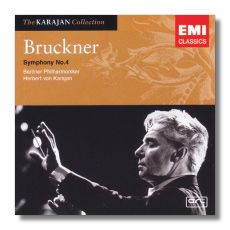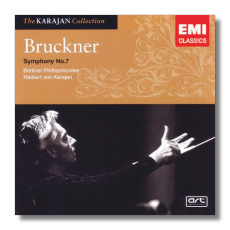
The Internet's Premier Classical Music Source
Related Links
- Latest Reviews
- More Reviews
-
By Composer
-
Collections
DVD & Blu-ray
Books
Concert Reviews
Articles/Interviews
Software
Audio
Search Amazon
Recommended Links
Site News
 CD Review
CD Review
The Karajan Collection

Anton Bruckner
- Symphony #4 in E Flat Major, "Romantic"
Berlin Philharmonic Orchestra/Herbert von Karajan
EMI Classics 476887-2 ADD 70:14


Anton Bruckner
- Symphony #7 in E Major
Berlin Philharmonic Orchestra/Herbert von Karajan
EMI Classics 476888-2 ADD 68:06


- Anton Bruckner: Symphony #8 in C minor
- Carl Maria von Weber: Der Freischütz: Overture
- Felix Mendelssohn: Hebrides Overture
- Richard Wagner: Der fliegende Holländer: Overture
- Otto Nicolai: Die lustigen Weiber von Windsor: Overture
Berlin Philharmonic Orchestra/Herbert von Karajan
EMI Classics 476901-2 ADD 2CDs: 60:44, 67:36


Antonín Dvořák
- Symphony #8 in G minor, Op. 88
- Symphony #9 in E minor, Op. 95, "From the New World"
Berlin Philharmonic Orchestra/Herbert von Karajan
EMI Classics 476898-2 ADD 78:07


Waltzes & Polkas
- Johann Strauss II:
- An der schönen, blauen Donau
- Wiener blut
- Pizzicato-Polka
- Kaiser-Walzer
- G'schichten aus dem Wienerwald
- Perpetuum mobile
- Wein, Weib und Gesang-Walzer
- Leichtes Blut
- Unter Donner und Blitz
- Tritsch-Tratsch-Polka
- Josef Strauss:
- Sphärenklänge-Walzer
- Transaktionen-Walzer
- Delirien-Walzer
Vienna Philharmonic Orchestra/Herbert von Karajan
EMI Classics 476879-2 ADD mono 76:19
Deutsche Grammophon has kept its Herbert von Karajan recordings in the catalogue pretty much without interruption. EMI, on the other hand, has not been so consistent. The good thing is that this label seldom deletes its most desirable recordings permanently. For example, EMI now is reissuing their Karajan recordings again under the heading of "The Karajan Collection," and this handful of releases is among the newest reissues in this series.
Karajan recorded all of Bruckner's numbered symphonies for Deutsche Grammophon – some of them more than once – but just three of them for EMI. Although these recordings are analog, no excuses need to be made for the engineering. This is particularly true for the Fourth and Seventh Symphonies, which were recorded in 1970-71. (The Eighth Symphony was recorded in 1957.) In general, the EMI recordings give a sense of the various recording venues more than Deutsche Grammophon's, which seem a little over-engineered at times. Different venues were used for all three. The Fourth was recorded in the Philharmonie, the Seventh (probably the best of all, in terms of sound) in Berlin's Jesus-Christus Kirche, and the Eighth in the somewhat cavernous sounding Grunewaldkirche.
Karajan sometimes was criticized for creating beautiful orchestral sonorities without going deeply beneath the surface of the music. His Bruckner is undeniably beautiful, but there's no lack of attention paid to the composer's spirituality. The music is never trivialized. Furthermore, although there's never any let-up in the conductor's control over what is going on in the orchestra, down to the smallest detail, freshness and spontaneity are maintained. Karajan's grasp of the music's ebb and flow – what sometimes is referred to as "architecture" – prevents Bruckner's music from seeming tedious, which is always a danger for listeners not accustomed to the composer's long paragraphs. Indeed, one wishes that some movements would go on longer – for example, the Finale of the Seventh. Karajan's recordings are recommended for listeners who are looking for an introduction to Bruckner. (Indeed, such was the case for me, about 25 years ago.)
The four overtures which accompany Bruckner's Eighth are a welcome makeweight, originally recorded in 1960 (also in the Grunewaldkirche). Der Freischütz is amply dramatic, without turning pushy in the style of Toscanini, and the Mendelssohn Hebrides is unusually dark and stormy. Best of the four is Die lustigen Weiber von Windsor which is a feast of rough good humor, just like fat Falstaff himself.
Karajan's pair of Dvořák symphonies date from 1979 and 1977, respectively. (Again, these are symphonies which Karajan recorded several times, including in the digital era.) By this time, his tempos were becoming slower – a preview of the beautiful yet sometimes static conducting that was to come in the digital era. In terms of temperament, the Eighth and Ninth symphonies are very different. Karajan minimizes those differences, however, and he does this by making the Ninth a more elegiac work than we are used to. Only in the final Allegro con fuoco does Karajan allow the Berlin Philharmonic to build up a head of steam. Throughout, the orchestra plays with wonderful sensitivity, and the closing moments of the Largo are memorable in their rapt stillness. Here, one seldom feels that this symphony is a good example of Czech nationalism, however; Karajan pulls it further to the West, as it were, and gives it a Germanic sound. Since this is the "New World," I guess a case can be made for an interpretation such as this one. With generous string portamenti and relaxed rhythmic pointing, Karajan also washes the Czech character out of the Eighth Symphony. The result, unsurprisingly, is beautiful, and even sentimental. Karajan's Dvořák is hardly idiomatic then, but the sounds he makes (along with the Berlin Philharmonic, of course!) are hard to resist. Both symphonies were recorded in the Philharmonie, and the late analog sound continues to be impressive.
It would not be too much of an exaggeration to say that the members of the Vienna Philharmonic are genetically predisposed to excel in music by the Strauss family. It would take a conductor who was a Superman of awfulness to lead this orchestra in a bad performance of the Blue Danube Waltz. From the beginning of his career, Karajan liked to conduct this music, but sometimes he interfered with its natural flow too much, gilding the lily, as it were. That's not the case with these recordings. The perfect balance between the conductor and the orchestra means that these readings have both Karajan's distinctive personality and Viennese authenticity. Indeed, Karajan was hard-pressed to surpass what he achieved here. Take, for instance, the Perpetuum mobile, which here has the ability to make the listener laugh out loud. Karajan was not known for finding humor in the music he conducted, so this is a particularly treasurable example.
These recordings date from 1946-49, were recorded in the Musikvereinssaal, and originally were released on 78-rpm discs. That explains why the longer waltzes are slightly cut; there's no zither solo near the end of Tales from the Vienna Woods, for example. (To include it would have necessitated an additional side.) The engineering is excellent, given its age. Also, Karajan alters the scoring of the Emperor Waltz, giving a cello solo to the entire cello section. The digital remastering dates from 1997.
Copyright © 2005, Raymond Tuttle




















